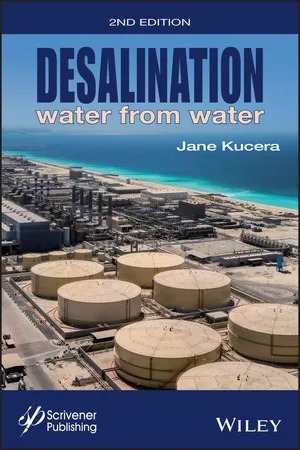
Desalination
Water from Water
Jane Kucera
- English
- ePUB (mobile friendly)
- Available on iOS & Android
Desalination
Water from Water
Jane Kucera
About This Book
This all-new revised edition of a modern classic is the most comprehensive and up-to-date coverage of the "green" process of desalination in industrial and municipal applications, covering all of the processes and equipment necessary to design, operate, and troubleshoot desalination systems. This is becoming increasingly more important for not only our world's industries, but our world's populations, as pure water becomes more and more scarce.
"Blue is the new green." This is an all-new revised edition of a modern classic on one of the most important subjects in engineering: Water. Featuring a total revision of the initial volume, this is the most comprehensive and up-to-date coverage of the process of desalination in industrial and municipal applications, a technology that is becoming increasingly more important as more and more companies choose to "go green." This book covers all of the processes and equipment necessary to design, operate, and troubleshoot desalination systems, from the fundamental principles of desalination technology and membranes to the much more advanced engineering principles necessary for designing a desalination system. Earlier chapters cover the basic principles, the economics of desalination, basic terms and definitions, and essential equipment.
The book then goes into the thermal processes involved in desalination, such as various methods of evaporation, distillation, recompression, and multistage flash. Following that is an exhaustive discussion of the membrane processes involved in desalination, such as reverse osmosis, forward osmosis, and electrodialysis. Finally, the book concludes with a chapter on the future of these technologies and their place in industry and how they can be of use to society.
This book is a must-have for anyone working in water, for engineers, technicians, scientists working in research and development, and operators. It is also useful as a textbook for graduate classes studying industrial water applications.
Frequently asked questions
Information
Chapter 1
Introduction to Desalination
Abstract
1.1 Introduction
Table of contents
- Cover
- Preface
- Chapter 1: Introduction to Desalination
- Chapter 2: Thermal Desalination Processes
- Chapter 3: Basic Terms and Definitions
- Chapter 4: Nanofiltration – Theory and Application
- Chapter 5: Forward Osmosis
- Chapter 6: Electrodialysis Desalination
- Chapter 7: Continuous Electrodeionization
- Chapter 8: Membrane Distillation: Now and Future
- Chapter 9: Humidification-Dehumidification Desalination
- Chapter 10: Freezing-Melting Desalination Processes
- Chapter 11: Ion Exchange in Desalination
- Chapter 12: Electrosorption of Heavy Metals with Capacitive Deionization: Water Reuse, Desalination and Resources Recovery
- Chapter 13: Solar Desalination
- Chapter 14: Wind Energy Powered Desalination Systems
- Chapter 15: Geothermal Desalination
- Chapter 16: Future Expectations
- List of Contributors
- Index
- End User License Agreement